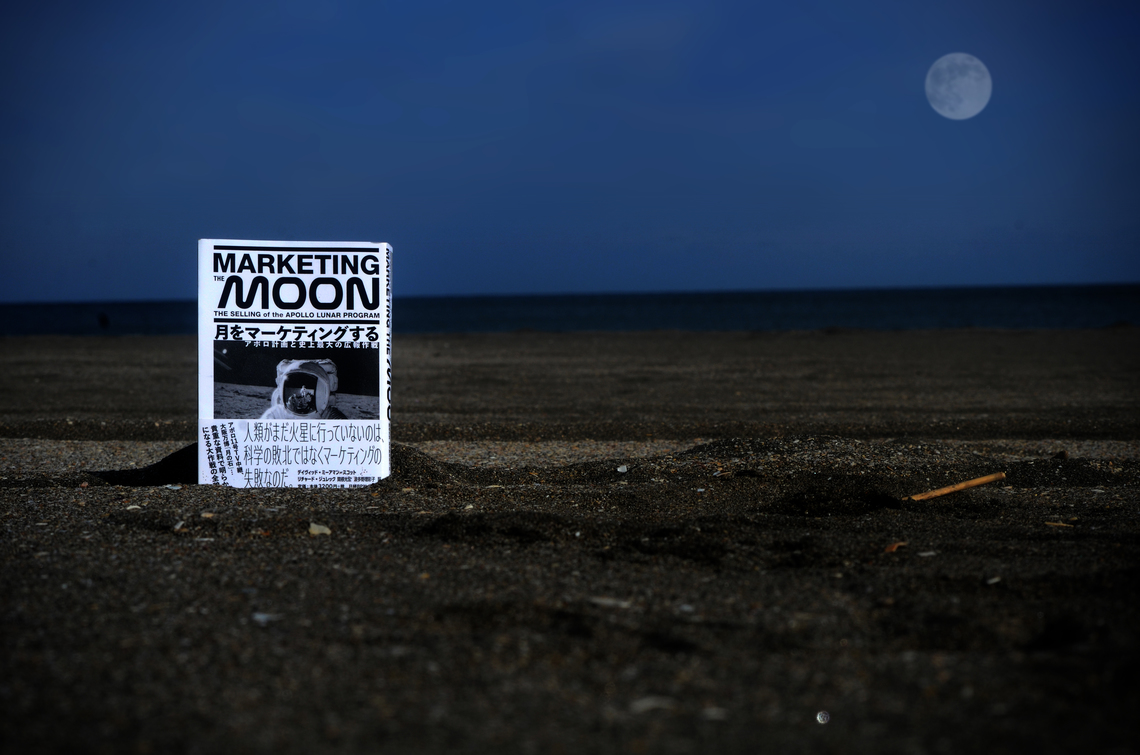A ticket to the moon, $25 billion.
What was the massive campaign that sold such a staggering ticket to the American public?
The book we're covering this time, Marketing the Moon by David Meerman Scott and Richard Jurek (Nikkei BP), is one that unravels the full scope of the Apollo program from this marketing perspective.

Marketing might just top the list of "things everyone knows the word for but doesn't really understand." It's a field I personally struggle with, but this book, which explains such a grand-scale operation with astonishing precision, will undoubtedly make you excited about marketing.
"
It is not a failure of science,but a failure of marketing."
This book, whose cover boldly declares such provocative words, thoroughly dissects the Apollo program—a scientific feat—as the largest and most crucial marketing campaign in history.
In recent years, there's been increasing talk of "human-centered innovation, not technology-centered." This book precisely reveals the human and business aspects hidden behind cutting-edge technological innovation.
The author is David Meerman Scott.
He is a renowned marketing expert, best known for publishing "Learning Marketing from the Grateful Dead" (Nikkei BP), which became a bestseller in Japan three years ago under the supervision of Shigesato Itoi.
Communicate your vision and capture early adopters.
1957: The world's first artificial satellite, Sputnik 1, successfully launched.
In 1961, Yuri Gagarin became the first human in space.
While the Soviet Union was achieving one space success after another, NASA was established in 1958.
While this might seem like an unfavorable start, public perception was different.
In fact, for years prior, the dream of space had been repeatedly shared in America through science fiction dramas, theme parks, and even magazine feature articles.
What they depicted was a vision of the future.
In essence, by articulating a vision for space business, they were steadily cultivating fans who would become early adopters.
Through "open communications," it focused on reporting, not promotion.
Gaining public empathy for NASA's endeavors.
In doing so, one principle played a major role:
It was the principle that "NASA's public relations is not advertising, but reporting. "
They recruited individuals with experience working in newspapers, magazines, television, and other media outlets, assembling a team that understood how the media operates.
The information disseminated shifted from visionary statements to fact-based reporting. They also provided short videos under five minutes to TV stations free of charge and won over journalists one by one through open information sharing.
Meanwhile, they secured an exclusive contract with LIFE magazine for astronauts' private information, barring any other media from publishing it. This skillfully controlled the branding of astronauts—presenting them not as heroes, but as relatable individuals. In today's terms, you might call it content marketing. What cunning.
The "live television broadcast" that created a shared global experience.
Among the series of marketing campaigns, the live broadcast of the moon landing particularly captivated the world.
Gene Cernan, the "last man to walk on the moon," reflected:
We were all together in space. That's the magic of television. It brought other people into space with us. (P.250)
This live broadcast initially faced significant opposition. After all, cameras weren't necessary for the landing itself, so the argument "Instead of that extra weight, load more equipment needed for the flight" was perfectly understandable.
But in the end, this live broadcast was a huge success. The entire world witnessed the moon landing, the dream of space, and everyone became a fan of NASA. It was a very NASA-like marketing activity, mastering the use of content and building relationships with the media.
The greatest enemy in marketing is indifference.
Yet, just three years after the first moon landing, the Apollo program began its descent toward its end. Its enemy was public indifference. News of moon landings no longer dominated the headlines. Even holding astronaut parades or sending moon rocks on a world tour couldn't reverse the tide.
One reason was that the grand mission of "sending humans to the moon" had been accomplished. Precisely because it had such a strong, overarching purpose, the Apollo program closed its chapter without finding the next grand mission to pursue. Forty years later, humanity still hasn't reached Mars.
The Apollo program, which gave humanity dreams from start to finish.
While reading, I found many parallels with Japan's bid for the Tokyo Olympics and Paralympics. What dreams will spread across Japan as we look toward the future? What new visions will emerge beyond 2020?
This is a substantial volume full of lessons for anyone tackling a major undertaking, or aspiring to do so.





